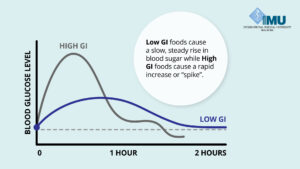Prof Winnie Chee Siew Swee, Professor of Nutrition & Dietetics at the IMU-CTNH (in the photo above) is one of the contributors to this article.
One of the most common challenges that people all over the world face is that of eating healthy and controlling our meal portions. Some of us struggle with it to help with weight issues, others have to keep an eye on their food intake for particular health conditions. Others just want to maintain a healthy lifestyle. Whatever the motivations, one thing is true for Malaysians–and those with non-Western diets–it is a lot harder to find nutritional information, such as the glycemic index, about local fare as opposed to Western dishes. A recent collaboration between two institutions–one in Malaysia and the other in Singapore–to chart the glycemic index of Asian foods is the first step in rectifying this. You’re about to bite into your favourite pandan chiffon cake but you remember reading an article about the glycemic index (GI) of foods and how this affects your blood sugar level. “What is the GI for a chiffon cake?” you wonder. You quickly whip out your phone to google it…but nothing turns up. It’s a common roadblock. Search the GI of a strawberry shortcake and you will immediately find numerous resources including recipes for a lower GI version and a list of other foods with comparable GI values. For a chiffon cake, however, you would need to be a GI Joe of the nutrition world to track down the same data. Dr Sangeetha Shyam from IMU’s Centre for Transformative Nutrition and Health (CTNH) says, “As part of my doctoral work at IMU, we had pioneered the DIETPLUS Version 3, a programme that works as a Malaysian GI and nutrient calculator. It was created to support low GI dietary studies in Malaysia. This was in 2010 and we have freely circulated this calculator to all Malaysian nutrition and health researchers.” However, this has not been enough and with GI gaining a lot more traction from the profession as well as individual folk, there has been an urgent need to update and improve the accuracy and accessibility of the glycemic index of Malaysian foods. Over the last two years, Dr Sangeetha was one of the five scientists from IMU-CTNH and A-Star Singapore that collaborated to put together a GI compendium of non-western foods. The team was led by Prof Jeyakumar Henry, a senior advisor at Agency for Science, Technology and Research’s Singapore Institute of Food and Biotechnology Innovation (SIFBI). He says: “It was very difficult to access GI values of Asian and non-western foods as there was no database and international databases gave very little focus to the region. I began my work in GI 25 years ago in the United Kingdom and when I moved to Singapore in 2011, I was acutely aware of the paucity of GI values for Asian and non-western foods.” Together, the team managed to put together a list of 940 foods from 16 Asian and Middle Eastern countries including Malaysia, Singapore, Thailand, Taiwan, Hong Kong, India, Sri Lanka, UAE and Saudi Arabia. This list includes items such as nasi lemak, red bean pau and yes, even chiffon cake!
What is GI?
Carbohydrates are broken down to sugar during digestion and are absorbed into the blood. This then affects our blood sugar levels. GI is a number that indicates the quality of carbohydrates in foods. The higher the GI of a food, the higher and more rapidly it raises blood sugar when consumed. Food is categorised as having a high GI if its GI value is 70 and above. Foods with a GI of 56 to 69 are placed in the medium GI category. A low GI food has a GI of 55 or lower. For example, roti jala with chicken curry has a GI of 81, chiffon cake has 60 while yellow-fleshed watermelon has a GI of 47.
“Knowing these numbers is important for consumers to make an informed choice especially for those who want to watch their weight or control their diabetes,” says Dr Sangeetha. She adds that GI values have become even more important in light of today’s COVID-19 pandemic. “It has made us acutely aware of the health implications of unhealthy diets, obesity and diabetes. Both diabetes and obesity are associated with raised blood sugar levels that increase inflammation. High levels of inflammation can compromise immunity and make people more susceptible to infections.”
| Carbs–quality over quantity |
|---|
| Controlling carbohydrates has long been the focus with low-carb, high-protein diets still very popular. While it seems logical that reducing our intake of carbs will help us to reduce our blood sugar levels, mainstream scientific evidence does not support low-carbohydrate diets. According to Dr Sangeetha, it is unnecessary and even dangerous to completely cut out carbohydrates as the current evidence and mainstream consensus is that both high- and low-carbohydrate diets increase mortality. “Very low carbohydrate or keto diets are considered experimental and lacking in evidence in terms of long-term safety,” she says. According to her, a good balance is when carbohydrates provide about half our energy needs. “In Asia, our diets are particularly high in carbohydrates. In a typical Asian diet, 50 to 80 per cent of energy comes from carbs, way higher than Western diets which tend to be heavier in proteins,” Dr Sangeetha says. Reducing drastically or completely cutting out carbohydrates from an Asian diet would mean that our plates would have little or no staples and would probably cost a lot more. “It’s not sustainable–and most times not affordable–to have a low-carbohydrate diet. What is more important, and what we should focus on, is the kind of carbohydrates we ingest,” she says. This is where GI plays an important role. The GI of a food enables us to choose the type of carbohydrates we consume by basing our diet on quality—that is, low GI foods—rather than focusing only on quantity. |
Some things we can’t change
While we are able to choose better quality carbs, there are other factors that affect our blood sugar levels which we cannot change, and that’s our phenotypes. Phenotypes categorise people under observable characteristics including behaviour, colour, shape and size. The Asian phenotype has been categorised as TOFI–thin on the outside, fat on the inside. “This means that at the same BMI, an Asian has higher body fat than a Caucasian,” says Prof Winnie Chee Siew Swee, Professor of Nutrition & Dietetics at the IMU-CTNH. “One of the consequences of this is that we get chronic diseases such as diabetes at much lower BMIs,” she explains. According to Prof Winnie, our phenotype also affects the way our bodies break down sugar. “When compared to Caucasians, Asians produce a high blood glucose response to the same amount of carbohydrates,” she says. Our Asian genes may also have a part to play in this but studies are still at an infancy stage. All of these factors build up the case of why lower GI foods are so important to Malaysians. “Our lifestyles are also more sedentary compared to those in the West. We have longer working hours, security concerns, hot and humid climate and a matter of cultural reluctance for exercise. These add on to our high rates of obesity and diabetes in the community,” Prof Winnie adds.
| First step forward! |
|---|
| It almost seems like the cards are stacked up against us, but there are simple things that you can do to take the first steps to a healthier life especially for people with diabetes, pre-diabetes or even a family history of diabetes. “GI is a diet optimisation tool that should be used in conjunction with other dietary principles of moderation, balance and variety. We must not forget that calories and the amount of carbohydrates still count, there’s no escaping that. But you can further improve your food choice by lowering your GI to manage your weight and blood sugar,” says Dr Sangeetha. A GI-based diet is a lot more flexible and not as restrictive as other diets such as the keto (a very low-carb, high-fat diet). It is about combining the right foods in appropriate portions. First, you can choose lower GI versions of your staple, for example swap white bread for wholemeal or eat a different type of rice grain (Basmati rice has a lower GI at 50 as compared to Jasmine rice at 78.7). Secondly, you can choose to combine foods more effectively. For example, when we combine rice with veggies and meat (or egg and dhal) the high GI of the rice will be lowered by the lower GI of vegetables and meat. “An easy way to remember how to portion your food is to fill half your plate with fruits and vegetables, another quarter with protein and the last quarter with carbohydrates. Eating your vegetables first and carbohydrate last will also further reduce the impact on blood sugar level,” adds Prof Winnie Chee. Keep in mind that GI values only track carbohydrates. This means we can compare GI levels between bread and rice, but we cannot compare rice with meats for example. “Red meats such as mutton and beef do not have a GI value. When you replace rice with red meats you are reducing carbs, but remember you are also increasing the protein and fat. This will have its own health consequence,” Dr Sangeetha says. Avoid over-cooking though, adds Dr Sangeetha: “Any process, including cooking, that makes carbs more digestible increases their GI. For instance, if you cook low GI pasta longer, its GI may increase a few points.” |
What’s next?
Besides helping individuals make better choices, it is hoped that the compendium will help the work of key stakeholders in the area of body weight and diabetes management, in particular those in the Asian region. These include dietitians, nutritionists, family and general physicians and endocrinologists or diabetologists; as well as the food industry that can aim to come up with healthier low-GI food options. Currently 70 out of the 940 foods listed are from Malaysia. While this represents a very small proportion of foods, it does include the staple carbohydrates consumed in Malaysia. There’s much more to be done though and CTNH plans to lead the effort to analyse foods from all of the states. Traditional Asian cuisine also provides us with lots of spices and condiments such as fenugreek, cinnamon, ginger, garlic, vinegar and other herbs. These are known to lower your blood sugar response and according to Dr Sangeetha, there is immense potential in experimenting with these. One piece of good news for food-loving Malaysians: complementary ingredients such as spices are not included in the GI table as they contain very little carbs and the usual amounts that are eaten do not affect our body’s blood sugar responses. “By controlling your portion size (half fruit and vegetables, quarter protein and quarter carbs) and paying attention to how to combine high GI versions with low GI foods, you can enjoy your Malaysian meals!” says Prof Winnie.
| In the News | ||
|---|---|---|
| 14 November | Daily Straits | Indexing Our Local Food |










